Tinea versicolor develops when a certain type of fungus attacks the skin, causing infection. The fungus interferes with the color pigmentation of the skin causing the affected area to become darker or lighter. Individuals affected by this condition have irregular discolored patches on the skin particularly on the oily areas of the body, like the chest, back, upper arms and neck. The patches could appear red, pink, white or brown and come with mild itching. Though this skin infection is not contagious, but it can cause great deal of embarrassment.
The fungal infection responds to prescription and over-the-counter antifungal medicines, creams, lotions and even shampoos. Still, it may take some time for the skin discoloration to completely get back to normal. Moreover, some may find that the condition has recurred even when the patches have not yet totally disappeared.
How does Tinea Versicolor look like?
This fungal infection is characterized by discolored patches on the skin that could be lighter or darker than the surrounding areas. They may appear brownish, pinkish, reddish or whitish in color. They develop slowly, are slightly itchy, and have fine scales and sharp edges. They frequently affect the neck, back, chest, upper arms and even underarms. They can even be found on the breast and groin area.
Tinea versicolor becomes more obvious after sun exposure. In fact, the discolored patches usually disappear when the weather is cool and resurface when it becomes humid and warm. In some cases, the patches may cover a big part of the body and cause a great deal of concern. Though the condition is harmless, it is still advisable to visit the doctor if self-care measures don’t work or if a large part of the body is affected.
What causes Tinea Versicolor?
What happens in the case of tinea versicolor is that there is an overgrowth of fungus, particularly yeast, on the skin resulting in infection. Two yeast pathogens had been identified to cause discolored skin patches, namely, Malassezia furfur and Malassezia globosa. These pathogens are normally present on the skin but problems arise when they become abundant.
Yeasts eat fats. The sebaceous glands secrete sebum or oil which contains high amounts of lipids or fats. It is not surprising why tinea versicolor is prominent in oily parts of the body. When yeast start to reproduce and become plentiful, they release a chemical that interrupts the normal function of melanocytes – a type of cell that determines the coloring or pigmentation of the skin. This causes the lightening or darkening effect on the affected area. Moreover, yeast pathogens take advantage of environmental changes by making the skin hospitable for other microorganisms that can cause infection.
Who is at risk of getting Tinea Versicolor?
Anyone can be affected by this fungal infection but some individuals have higher chances of getting them than others. The following are contributing factors:
- Living in the tropics or warm regions
Tinea versicolor is a year-round problem in tropical countries because the fungi flourish in hot and humid climate.
- Profuse sweating
Sweating excessively brings more oil to the skin, giving the yeast more food to enjoy and a favorable environment for reproduction.
- Oily skin
Oils are the yeasts’ food and having an unusually oily skin predisposes one to fungal infection even if he or she doesn’t sweat a lot.
- Weak immune system and hormonal imbalance
Bodily changes either because of hormonal imbalance or weak immunity can affect the body’s defense mechanism against fungal invasion.
Studies showed that tinea versicolor affects more teenagers and young adults, especially those living in tropical and subtropical countries. The condition affects up to 8% of the entire US population alone.
Tinea Versicolor Treatment
It is fairly easy and inexpensive to treat tinea versicolor. The treatment will largely depend on the location, size and extent of affected skin. Drugs used for treatment are typically prescribed by the doctor or purchased directly from a local drug store.
- Topical products
Topical products may come in the form of creams, soaps, lotions and even shampoos. They usually contain anti-fungal agents that effectively control the yeast population. Topical products can likewise be prescribed by a qualified doctor.
- Prescription anti-fungal pills
Prescription anti-fungal medications are often reserved for stubborn and recurrent fungal infections. Patients treated with prescription pills must be closely monitored by the doctor due to possible drug interactions. This is especially important for people being treated for other kinds of medical conditions.
It should be noted that skin discoloration may still linger for several months after treatment or even recur when the climate becomes warm. Individuals prone to the condition will benefit from adhering to some precautionary measures, such as:
- Staying away from oily skincare products
- Limiting sun exposure or applying non-greasy sunscreen protection
- Wearing loose fitting clothes
Sticking to a healthy diet and practicing good personal hygiene have also been proven helpful in managing and preventing the possible recurrence of tinea versicolor.
Tinea Versicolor Pictures
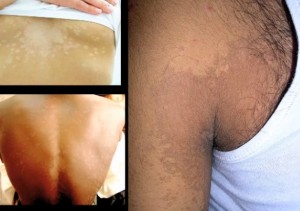
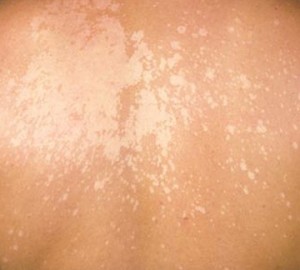

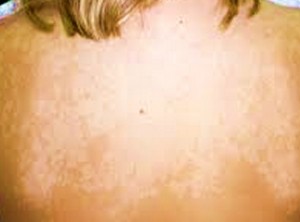
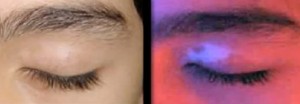
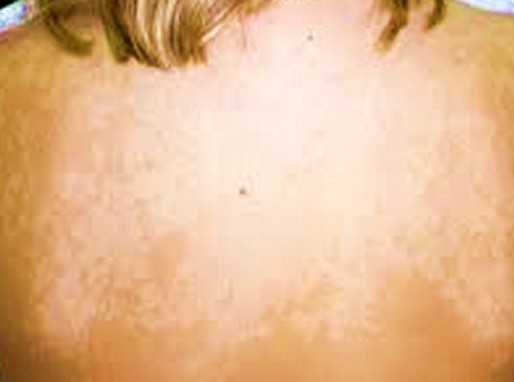

this is very helpful but i really want to know more on how one can get effected by this skin discoloration